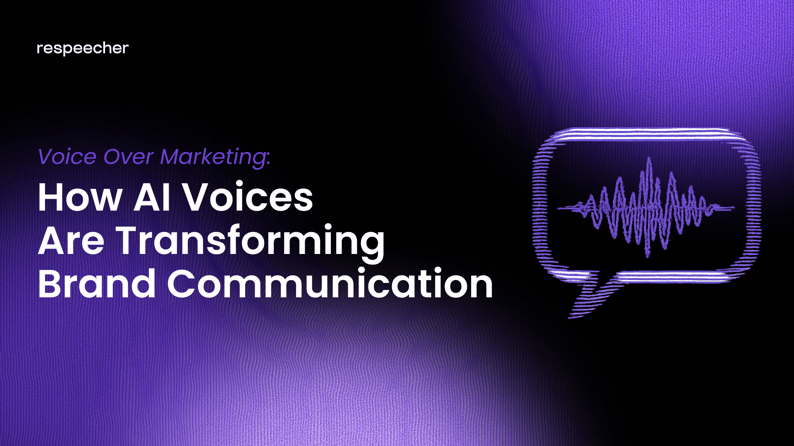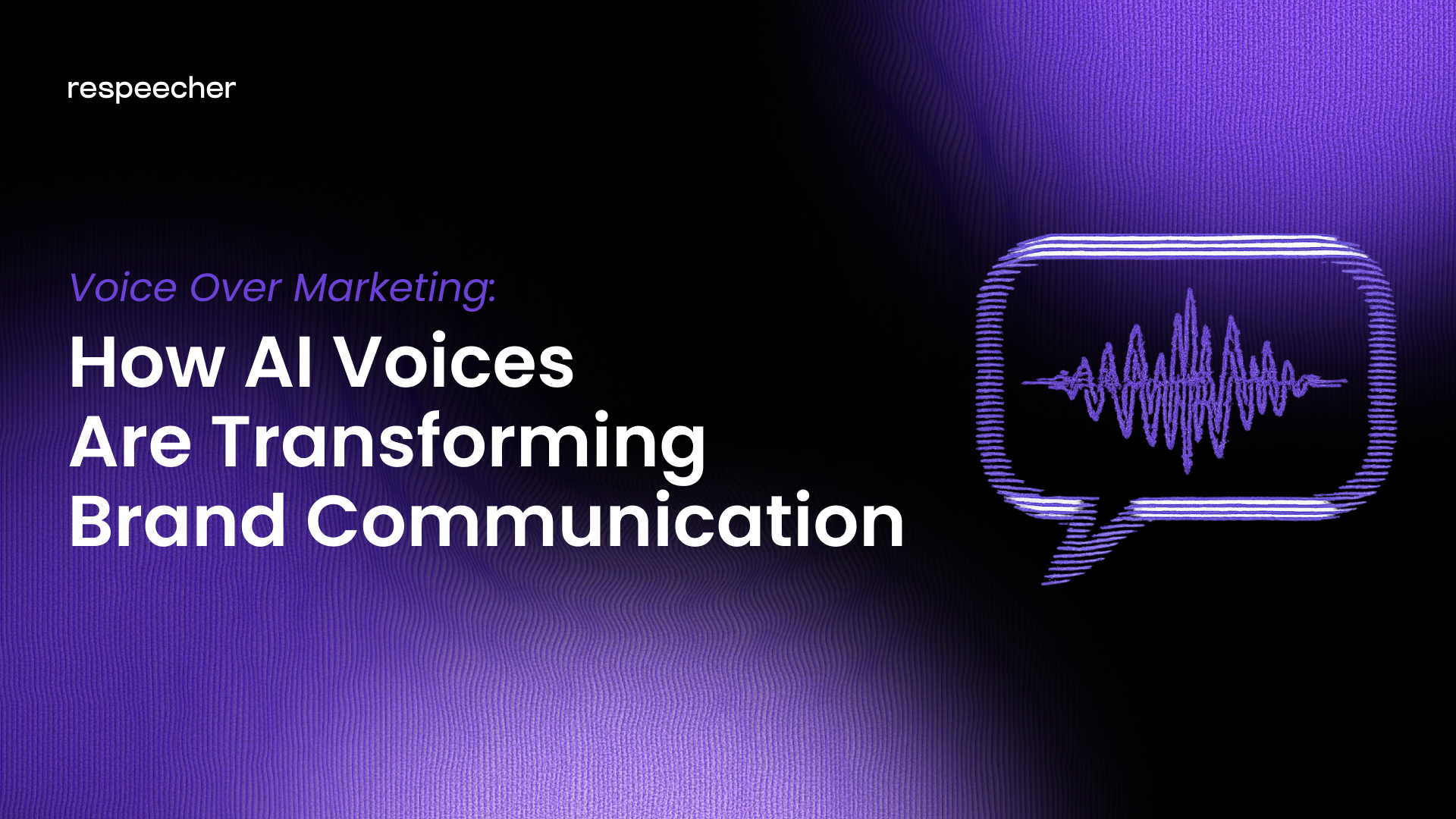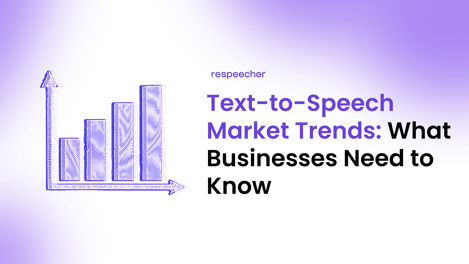Voice Over Marketing: How AI Voices Are Transforming Brand Communication

The debate around AI voices in creative work is loud, to say the least. A mix of excitement about new possibilities and legitimate fear about ethics, job security, and creative control. For any director, producer, or brand leader, it can be hard to separate the shiny useful tools from the unregulated ones.
This article is your guide to the voice over marketing essentials in this new era. We’re going to look at how professional AI voice, when used ethically and in partnership with talent, is becoming a powerful new tool in voice over marketing. We'll show you five practical ways that high-level creative teams are using AI to build and scale their brand's sound.
Key Takeaways
- The main power of professional AI voice is consistency at scale. It allows one signature brand voice to be present in global ad campaigns, product demos, and daily social media videos.
- The crucial distinction in AI voice is ethics. Professional, high-quality synthesis is always built on a fair and compensated partnership with an actor. Anything less creates unacceptable legal and creative risks for a brand.
- AI voice will never be a replacement for talent. Its real power is in the hands of creative teams who use it to solve complex production challenges and push more ambitious stories.
What Is Voice Over Marketing — And Why It Matters Now More Than Ever
Voice over marketing is a strategy for keeping your brand’s audio identity consistent across every single project. Just as you recognize a certain voice in a crowded room, your audience can instantly recognize your brand's voice.
Sound creates an immediate sense of familiarity, and for an audience, that’s exactly what builds trust. The basics of voice over marketing involve turning a company name into a voice people know and welcome.
Traditional vs. AI Voice Overs: What’s Changed?
In a traditional voice over session, the actor controls their performance, the director guides the creative vision, and everything happens in a securely professional environment. We’ve got a closed-loop and trusted process here.
The promise of AI voice overs was simple: create consistent, high-quality audio at a scale that was never before possible. Creative teams got a way to maintain a perfect vocal identity across hundreds, even thousands of assets.
But that promise came with an immediate threat. The first wave of AI voice tools treated voices as data to be scraped, which sparked the legitimate fear of actors losing control of their voices without their knowledge, consent, or compensation.
As a direct response to that chaos, we got ethical voice synthesis models. It’s a professional partnership starting with the actor's permission where they sign clear agreements defining how their digital voice will be used. The technology serves as a tool to scale their talent for specific tasks. And, of course, actors always get fair compensation for their work. It turns voice over marketing back into a controllable way to expand an artist’s reach, not exploit it.
5 Smart Ways Brands Use AI Voice Over in Marketing
What can you actually do with an ethical AI voice? The technology unlocks several powerful voice over marketing methods that were previously too costly or time-consuming to execute. Here are five smart ways creative teams use professional AI voice today.
1. Build Trust with a Consistent Narrator
You know it the moment you hear it: that relaxed, storytelling drawl is Matthew McConaughey for Lincoln. The voice can become so tied to the brand it has become a huge part of their identity. And if the voice narrating your product demo is different from the one in your company story video, the entire brand feels less put-together.
You can pick one professional AI voice, build in full partnership with a compensated actor or with a unique synthetic voice from ethically sourced and licensed data, and stick with it for all your core media content. When a customer hears a familiar voice explaining a new feature or telling your company's origin story, it builds a deep sense of reliability.
2. Give Your Brand Mascot a Voice for Any Occasion
Your brand mascot is a fan favorite, but their voice belongs to a single actor. Having them appear in daily content or react to new trends is a tough challenge. Just think that working around J.K. Simmons' schedule for a new M&M's TikTok post could take so long, you'd have to hope the trend is still relevant when the audio finally arrives.
This all changes with an official AI voice model, one that's built in full agreement with the mascot’s voice actor. A writer with a great idea for a social post will type the line into the platform, and get the audio back in minutes. And that’s it — that’s the entire process.
3. Future-Proof Your Brand's Sound Identity
What happens when your long-time narrator retires, or the actor for your mascot decides to move on from doing side gigs? You lose a piece of a brand's identity and will need lots of luck to try rebuilding that trust with your audience.
You can future-proof your brand with an official, ethically sourced, licensed AI voice model. Whether a new ad campaign or a product demo, you can produce content that always sounds like you, without being fully dependent on the actor's career path.
The film industry knows the value of preserving a character’s voice all too well: Respeecher's technology was used to synthesize a younger Luke Skywalker's voice for Disney's The Mandalorian. And what worked for a legendary Jedi will certainly work for your brand.
4. Maintain a Consistent Global Brand Voice
When your new brand video goes viral, you want to make it global. But that means launching it in 15 different countries, which also means hiring 15 different voice actors who all sound completely disjointed.
AI generates your consistent voice over in multiple languages. It preserves the exact tone and character of the original audio for the German, Japanese, Spanish or any other version of your ad all sound like they genuinely belong to one single brand.
5. Personalize Campaigns at Scale
An actor’s most valuable asset surely is their performance, but their time is finite. What if their one perfect take could be ethically amplified to create a personal connection with every single fan? Respeecher made this concept a reality in an award-winning project with Mondelēz and superstar Shah Rukh Khan showing support for local shop owners for the festival of Diwali.
A direct benefit here is taking a single master recording from your key talent—a celebrity spokesperson or lead actor—and using it to produce a wide range of promotional content. Every single output is guaranteed to honor the integrity of that artist-approved performance.
Building Your Voice Over Marketing Plan
A smart voice over marketing plan is a series of key decisions you make upfront to make your brand consistent and professional. It doesn't have to be a 50-page document no one will open twice. You can actually build one in just three steps:
Step #1. Define Your Brand’s Vocal Identity & Source
Decide what your brand would sound like if it could talk. Is it a calm expert? An energetic friend? Write down a couple of keywords that precisely describe this personality (e.g., "Confident, welcoming, clear").
Next, choose your voice source. You can hire an actor and, in full partnership with them, create an AI version of their voice for scalable content. Alternatively, work with a provider like Respeecher to create a unique synthetic voice from scratch that your brand owns exclusively.
Step #2. Create a Simple Style Guide
Your brand has a visual style guide, and you need one for your voice. It can be a simple one-page document that answers basic questions:
- Does our voice speak quickly or slowly?
- Is its tone formal and authoritative, or casual and friendly?
- Are there specific phrases it should use or avoid?
Step #3. Map Your Voice to Key Channels
Where will your audience actually hear this voice? Make a quick list of all the touchpoints:
- TV ads and social media videos
- Website's welcome video
- Product tutorials
- Podcast sponsorships
- Company's phone system (why not?)
Armed with that information, you’ll be confident where to implement the voice first and know for a fact no customer interaction is overlooked.
Expert Advice: How to Use AI Voices Responsibly
You can get an AI voiceover wrong in many ways: the tone is off, the script is lacking emotional nuance, or the pacing is simply bad. But the real failure is exploiting someone's voice without their permission. You do that — and none of the other issues matter.
The core principle of AI voiceovers should be respect for the talent. The technology is most powerful when it works alongside creative teams helping them, and not taking their place. When you use AI this way, you make sure the work stays ethical and the quality stays high.
"This trust, this respect, is important not just in terms of general ethics, and how we want to see our society move forward and adopt new technologies... What Respeecher is doing will open up possibilities for performers to play characters from anywhere in the world whilst also honoring the nations those characters are from.”
— Alex Serdiuk, Co-founder of Respeecher for The Gamer Interview
One of the most important voice over marketing tips: treat your commitment to ethical AI as a core part of your brand's voice. You get this right — you build real trust. Your audience will know you respect the artists behind the technology, and in turn, they'll respect your brand.
Why Companies Choose Respeecher
Respeecher is the dedicated team of audio specialists who step in to solve high-stakes vocal puzzles, like making an 80-year-old actor sound like they're 40 again or recreating a long-lost voice for a documentary. We are passionate about the art of the human voice and wanted to find a respectful way to preserve and extend it.
Companies come to us because they want a partner who understands one non-negotiable rule — consent is the ethical foundation of the project. They stay with us because they know we share their obsession with quality and will work tirelessly to capture the nuanced, human details of a performance.
But that's just our side of the story. The best way to understand our process is to hear directly from the creative partners we've worked with.
Final Thoughts
The real transformation AI brings to the voice over marketing niche is freeing creative teams from the worries about studio time, actor schedules, and global coordination — anything that could stop a great idea from coming to life.
But still, it all starts and ends with the human elements: the nuance of the original performance, the clarity of the director's vision, and, most importantly, the integrity of the ethical partnership. Get those right, and you can solve production challenges and start making things that weren't possible before.
Every great brand voice starts with a conversation. If you have a brilliant idea or a complex issue you're trying to solve, our team would love to hear about it.
FAQ
Voice over marketing is a strategy for making your brand's audio consistent everywhere. You build an audio personality that people feel connected to, and that connection helps build trust.
AI lets brands create consistent, high-quality audio at a high scale, and helps creative teams get around issues like actor availability and global coordination.
Voice over marketing starts with a simple idea: turning a company's name into a voice people know and trust. It involves defining a consistent vocal identity for your brand and using it for all your projects.
You can use a consistent narrator or give a voice to your brand mascot. You can also maintain a single brand voice for all your global content. AI is a great tool for doing all this, and it also lets you personalize campaigns at a massive scale.
In three steps. First, define your brand’s vocal identity. Second, create a simple style guide for that voice. Third, map out all the places your audience will hear it.
No. Our position at Respeecher is that AI is never meant to replace human actors. Instead, we use the technology to help creative teams and to expand an artist's reach in the most ethical way.
Treat your commitment to ethical AI as a core part of your brand's voice. This builds an indestructible trust with both artists and your audience.
It's the foundation of trust. Unethical usage, like using a person's voice without their permission, creates legal and creative risks for a brand. With a commitment to ethical AI, you show respect for artists while also protecting your brand.
Glossary
Voice Over Marketing
AI Voice
A creative tool that uses a synthetic voice, built from a real person's data, to produce new audio content.







